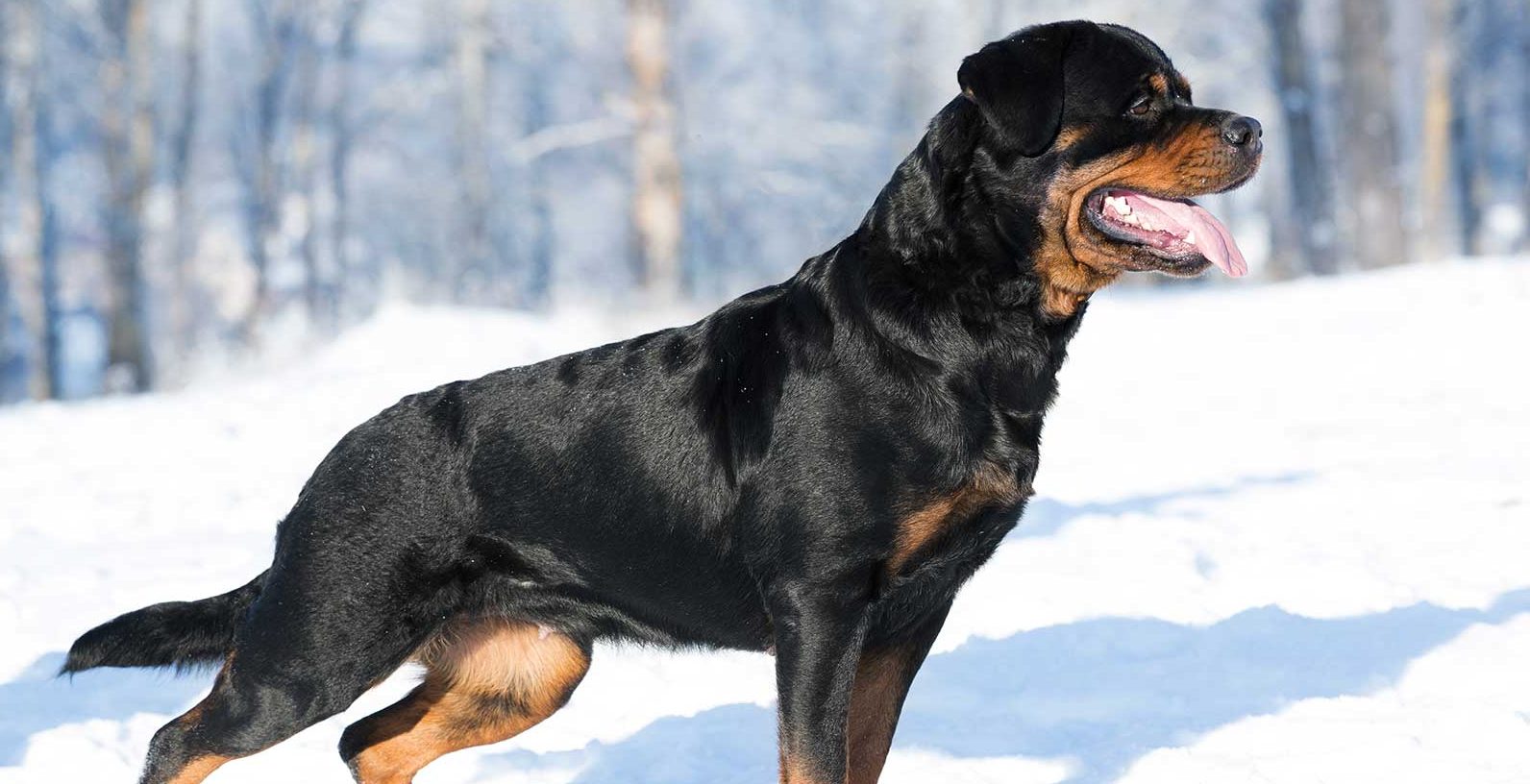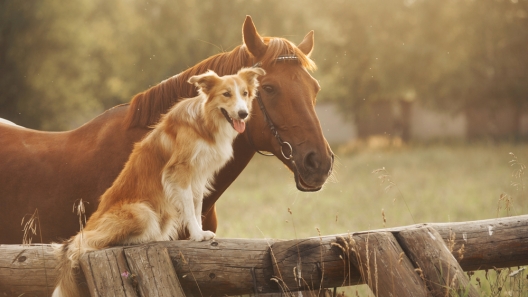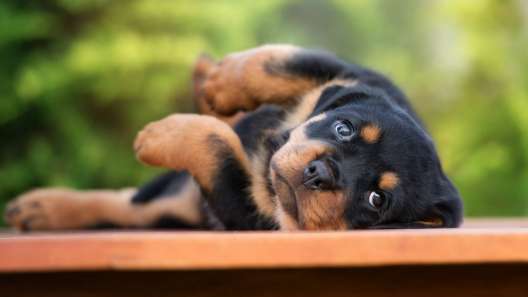-
Activity Level:
moderate
-
Shedding Level:
moderate
-
Grooming Level:
low
-
Trainability:
high
-
Good for Novice Owners:
moderate
-
Adaptability:
moderate
-
Kid/Pet Friendly:
often
-
Prey Drive:
low
-
Watchdog:
very alert
- Average Size: Large
- Average Lifespan: 9-10 years
- Registered?: aca, akc
Rottweiler Dog Breed Information
Overview
Temperament
Adaptability
Health
Owner Experience
Grooming
Activity Level
Size
Life Span
Did You Know?
The modern Rottweiler originated in Germany where they initially worked as cattle drovers to assist in keeping herds under control and guarding them against predators. Although their ancestors can be traced back as hard as the Roman Empire, the breed has changed little since 1901 when the first German breed standard was drawn up.
With the rise of the railroad during the 1800s, Rotties were used less for herding and guarding cattle. They quickly moved into other jobs and found work as police dogs, guard dogs, and all-around working dogs on farms, in factories, and more. Rotties also served heavily in WWI as police and security dogs.
A hard-working and intelligent dog breed, the Rottweiler is a top-tier police dog, service dog, search-and-rescue dog, or guard dog. The AKC recognized the Rottweiler in 1931 as a member of the Working Group. Over the years, the Rottweiler has become one of the most popular dog breeds and even reached the top of the AKC’s Most Registered Dog Breed list in the mid-1990s.
Rottweilers are protective dogs that bond closely with their families and are extremely affectionate with them. They are even considered one of the most affectionate dog breeds towards their families and favorite humans. With their families, they often show their playful and silly side while also cuddling up to their favorite humans while conveniently forgetting that they are not small lap dogs.
A normally calm and rather aloof dog breed, the Rottweiler can be as sweet-natured as they are protective. Their temperament is largely based on their owners and their owner’s willingness to properly socialize and train them. Rottweilers are one of the dog breeds that make good guard dogs, which only makes it more important to train and socialize them well early on.
Well-socialized Rotties tend to get along well with children as well as other dogs and other pets within the family. Even well-socialized, they may retain an initial wariness of strangers. They do tend to warm up once introduced. Individual dogs may warm up quicker than others and quickly accept pets from new friends while others may remain reserved and aloof.
Alert watchdogs, Rottweilers will tend to bark to alert you. They can be prone to barking and howling a lot if the behavior is left unchecked or encouraged. Training your dog to stop barking early on can help keep this from becoming a nuisance.
Rottweilers are moderately adaptable dogs. They prefer more open spaces and tend to be better suited for larger homes with fenced yards where they can run. They are even considered one of the best dog breeds for farms! Provided they are given plenty of exercise and attention every day, they may be able to adapt to apartment living, but are likely not a good fit for smaller apartments.
Although Rotties can do well in a variety of climates, they are very sensitive to heat. As such, you will want to keep an eye on them while out in hotter weather and also have some things on hand to help keep your dog cool. These dogs also bond closely with their families and thrive on attention from them, so they do not like to be left alone for long periods of time.
Potential health conditions to be aware of in Rottweilers can include hip dysplasia, elbow dysplasia, heart conditions, and eye diseases. Good breeding practices make a big difference in the health of Rottweiler puppies.
Reputable breeders will screen their dogs before breeding to avoid passing preventable issues to puppies. Make sure you ask about the health and genetic history of both parents. You can also ask about any health tests and clearances that have been done. The national breed club recommends hip and elbow evaluations, an ophthalmologist evaluation, a cardiac exam, and a Juvenile Laryngeal Paralysis & Polyneuropathy (JLPP) DNA test at a minimum.
Rottweilers are one of the smartest dog breeds. They are intelligent and willing to please, which makes them highly trainable. However, they can be a challenge for first-time dog owners as they require firm, consistent training with clear expectations and structure that is also based on positive praise and reward.
You have to build trust with a Rottie as a confident leader. Inconsistent training, harsh tones or training methods, or fear-based training damages the bond between you and your dog, which can also lead to them becoming stubborn and unresponsive to your commands. As such, they are recommended for more experienced owners, and puppy training classes are recommended for novice owners.
It’s also important to start leash training early and to train your dog not to jump up. Rotties are big puppies that grow into large, strong, and powerful dogs. As they grow in size and strength, they can easily become out of hand if not trained to walk well on a leash and can easily injure someone if permitted to jump on them.
The Rottweiler has a dense, double coat that is often black with brown on the legs, face, and chest. Rotties have short, smooth coats that will shed moderately year-round and a little heavier as seasons change. Weekly brushing, brushing more often during seasonal shedding, and the occasional bath as needed are usually enough to keep their coat healthy and looking great. They can be prone to drooling though, so you may want to have a waterproof mat around their water bowl and a drool cloth on hand to wipe their mouth every once in a while.
In addition to coat care, you will also need to take care of your Rottweiler’s nails, ears, and teeth. Cutting your dog’s nails once or twice a month is usually enough to keep them from growing too long. Weekly ear checks along with careful cleanings when needed can help prevent ear infections.
It’s also important to practice good dental care for dogs early and consistently throughout your dog’s life to prevent painful dental diseases later in life. Daily tooth brushing, along with cleanings at the vet when needed, is a good start. It’s also a good idea to get your Rottweiler puppy used to grooming, and looking forward to it, early on as this will make taking care of them much easier as they grow into large and powerful dogs.
Although the Rottweiler is a working breed that needs a job to do, they sit in a more moderate activity range. Daily walks plus some playtime and time to run are usually enough for this dog. They love being around you though, so they will likely be up for more activity if you are. Just make sure puppies are finished growing and developing before you move into higher-impact activities.
Keeping things low impact until they are done growing helps protect and avoid damage to developing bones and joints. Once they are cleared for more activities, you can try a lot of things with them. One of the facts about Rottweilers is that they are versatile working dogs and tend to be athletic. They can often enjoy swimming, hiking, training for dog sports, and more.
Fully-grown Rottweilers usually stand 22-27 inches tall and weigh 80-135 pounds. Females tend to stand 22-25 inches tall and weigh 80-100 pounds on average while males tend to stand 24-27 inches tall and weigh 95-135 pounds on average.
Rottweilers generally live for 9-10 years on average.
The Rottweiler’s name comes from their history of working as cattle dogs in the town of Rottweil. They were also among the first dog breeds used as guide dogs for the blind.









